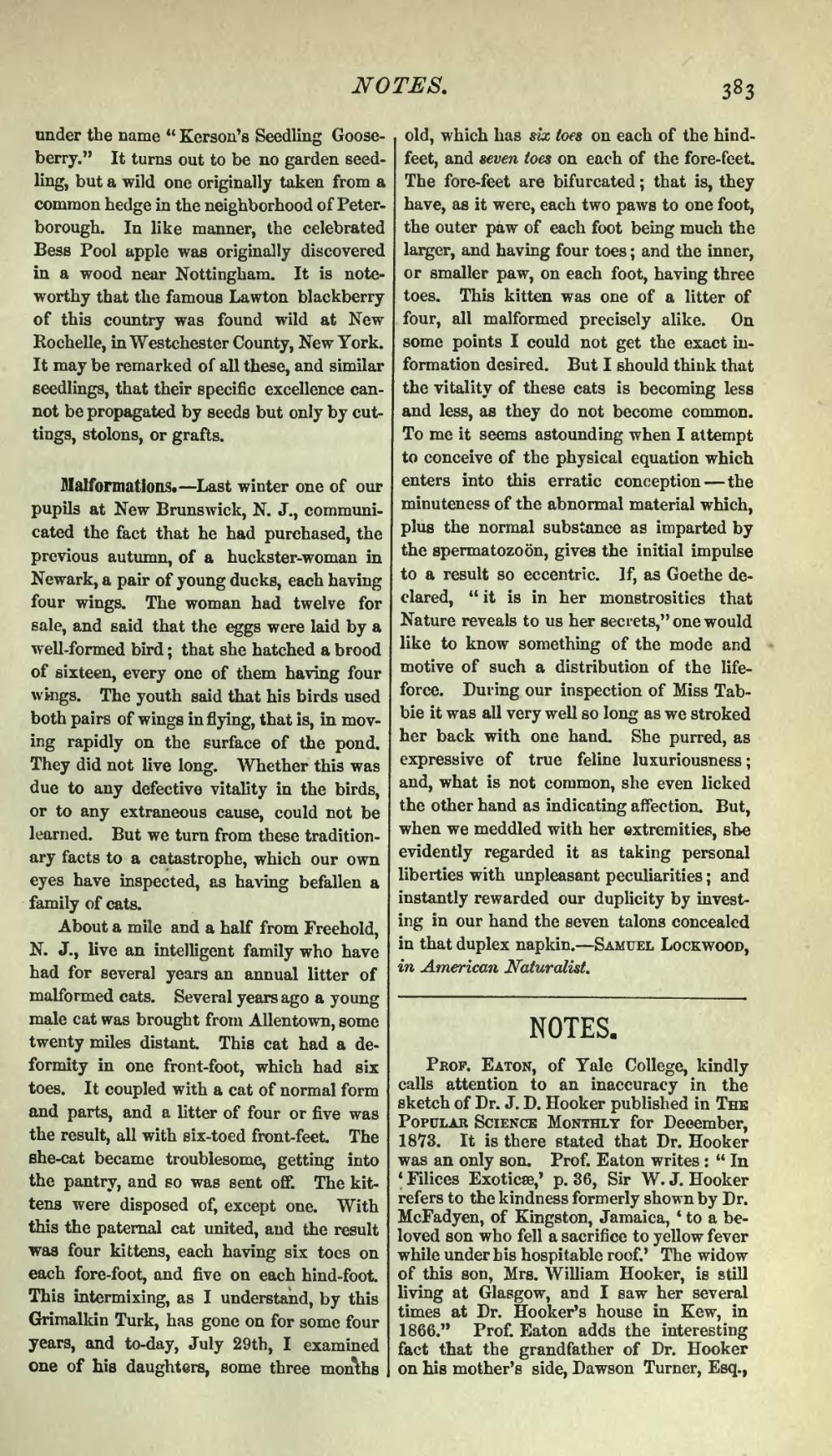under the name "Kerson's Seedling Gooseberry." It turns out to be no garden seedling, but a wild one originally taken from a common hedge in the neighborhood of Peterborough. In like manner, the celebrated Bess Pool apple was originally discovered in a wood near Nottingham. It is noteworthy that the famous Lawton blackberry of this country was found wild at New Rochelle, in Westchester County, New York. It may be remarked of all these, and similar seedlings, that their specific excellence cannot be propagated by seeds but only by cuttings, stolons, or grafts.
Malformations.—Last winter one of our pupils at New Brunswick, N. J., communicated the fact that he had purchased, the previous autumn, of a huckster-woman in Newark, a pair of young ducks, each having four wings. The woman had twelve for sale, and said that the eggs were laid by a well-formed bird; that she hatched a brood of sixteen, every one of them having four wings. The youth said that his birds used both pairs of wings in flying, that is, in moving rapidly on the surface of the pond. They did not live long. Whether this was due to any defective vitality in the birds, or to any extraneous cause, could not be learned. But we turn from these traditionary facts to a catastrophe, which our own eyes have inspected, as having befallen a family of cats.
About a mile and a half from Freehold, N. J., live an intelligent family who have had for several years an annual litter of malformed cats. Several years ago a young male cat was brought from Allentown, some twenty miles distant. This cat had a deformity in one front-foot, which had six toes. It coupled with a cat of normal form and parts, and a litter of four or five was the result, all with six-toed front-feet. The she-cat became troublesome, getting into the pantry, and so was sent off. The kittens were disposed of, except one. With this the paternal cat united, and the result was four kittens, each having six toes on each fore-foot, and five on each hind-foot. This intermixing, as I understand, by this Grimalkin Turk, has gone on for some four years, and to-day, July 29th, I examined one of his daughters, some three months old, which has six toe on each of the hind feet, and seven toes on each of the fore-feet. The fore-feet are bifurcated; that is, they have, as it were, each two paws to one foot, the outer paw of each foot being much the larger, and having four toes; and the inner, or smaller paw, on each foot, having three toes. This kitten was one of a litter of four, all malformed precisely alike. On some points I could not get the exact information desired. But I should think that the vitality of these cats is becoming less and less, as they do not become common. To me it seems astounding when I attempt to conceive of the physical equation which enters into this erratic conception—the minuteness of the abnormal material which, plus the normal substance as imparted by the spermatozoön, gives the initial impulse to a result so eccentric. If, as Goethe declared, "it is in her monstrosities that Nature reveals to us her secrets," one would like to know something of the mode and motive of such a distribution of the life-force. During our inspection of Miss Tabbie it was all very well so long as we stroked her back with one hand. She purred, as expressive of true feline luxuriousness; and, what is not common, she even licked the other hand as indicating affection. But, when we meddled with her extremities, she evidently regarded it as taking personal liberties with unpleasant peculiarities; and instantly rewarded our duplicity by investing in our hand the seven talons concealed in that duplex napkin.—Samuel Lockwood, in American Naturalist.
Prop. Eaton, of Yale College, kindly calls attention to an inaccuracy in the sketch of Dr. J. D. Hooker published in The Popular Science Monthly for December, 1873. It is there stated that Dr. Hooker was an only son. Prof. Eaton writes: "In 'Filices Exoticæ,' p. 36, Sir W. J. Hooker refers to the kindness formerly shown by Dr. McFadyen, of Kingston, Jamaica, 'to a beloved son who fell a sacrifice to yellow fever while under his hospitable roof.' The widow of this son, Mrs. William Hooker, is still living at Glasgow, and I saw her several times at Dr. Hooker's house in Kew, in 1866." Prof. Eaton adds the interesting fact that the grandfather of Dr. Hooker on his mother's side, Dawson Turner, Esq.,
